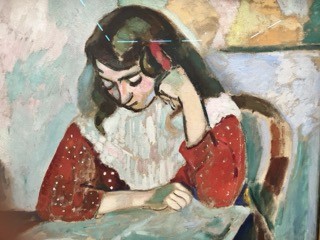While I was doing this at home, I was teaching undergrad teacher candidates at the university. My nascent teachers were puzzled: E. could read 25 words, knew her letter sounds, and could print using invented spelling (her best friend was named “KD”, for instance). Why couldn’t she read?
They assumed that knowing the letter sounds meant someone could read. They assumed that knowing some words made you a reader. Those skills are valuable, but there is no set amount of them that transform you into a reader.
Reading requires that you be able to make sense of the words and ideas of messages you’ve never seen before. If reading were only about word memorization, then we could only read texts of words already studied. If reading were mainly about “sounding out” words, then we’d all read much slower than we do.
One more element had to be added to this mix, an ingredient akin to the push that mama birds give to their babies when they want them to try to fly.
We got ahold of some old preprimers—these are the first books in the old basal readers. In most programs, there were three preprimers and they had rigorously controlled vocabularies. That just means that the texts used very few different words and they repeated them again and again.
We got our children reading these little books, telling them words that they didn’t know or getting them to sound out words that they could. In other words, we got them to try to read.
Surprisingly, this went more smoothly with our second daughter, M., the one who struggled with language and who was less interested in reading and books. I was puzzled by E.’s slow start, and in frustration asked, “Why can’t you read?”
Her answer surprised me. She said that if she could read, then I wouldn’t read to her anymore. She expressed what so many children (adults) feel about learning: learning can set you free, and they don‘t always seek such independence; it’s scary.
I explained that even if she could read, I would still read to her—and, by the next day, she could read. M. wasn’t as anxious about independence at this point, so she didn’t balk at all—though she had to work harder at this than her sister.
I used an approach that Pat Cunningham touted at the time and that still makes sense to me. Most schools took kids through these books over a semester. Pat argued that students should read two or even three sets of these little books in the same time period.
I obtained preprimers from three different companies, and my girls read all 9 of those books over a three-month period. By the end of that time, they could read. E. could read about a third-grade level when she entered Kindergarten, and M. read like a first grader.
How did we teach our girls to read? By reading to them. By teaching them letter sounds with curricula purchased at the local grocery store. By encouraging them to write. By having them dictate stories that we could write down for them. By having them read simple controlled vocabulary readers. By working with flash cards.
Many years ago, Dolores Durkin studied precocious readers; children who entered school already reading. Parents told her that they had not taught their kids to read. This finding was replicated repeatedly and teachers were told about these amazing children who taught themselves to read.
Eventually, the late Aileen Tobin asked the right questions. Instead of just asking parents whether they taught their children to read, she asked if they taught their kids the letters and letter sounds, how to print their names, words with flashcards, etc. She found that no one taught their children to read, but the parents of precocious readers were doing all of these things.

-Zomer-2.jpg)





Comments
See what others have to say about this topic.